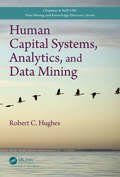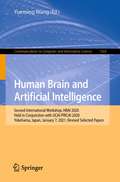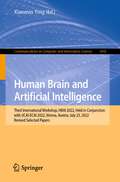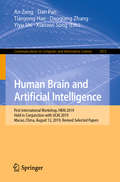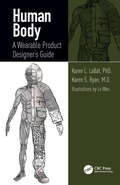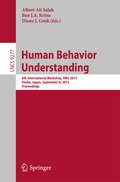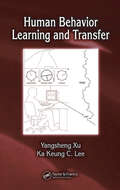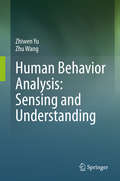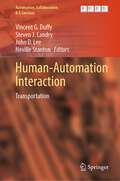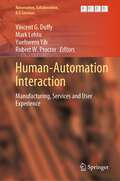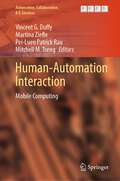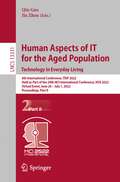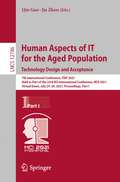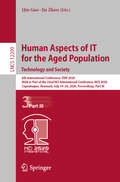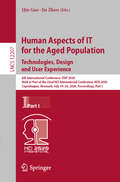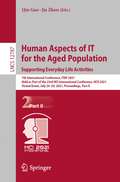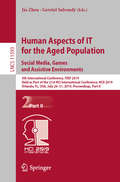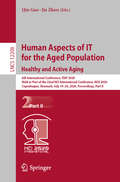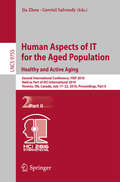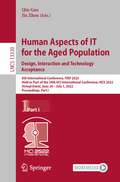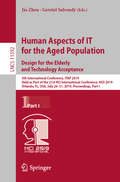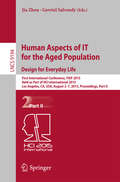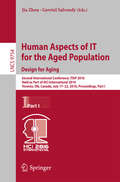- Table View
- List View
Human Capital Systems, Analytics, and Data Mining (Chapman & Hall/CRC Data Mining and Knowledge Discovery Series)
by Robert C. HughesHuman Capital Systems, Analytics, and Data Mining provides human capital professionals, researchers, and students with a comprehensive and portable guide to human capital systems, analytics and data mining. The main purpose of this book is to provide a rich tool set of methods and tutorials for Human Capital Management Systems (HCMS) database modeling, analytics, interactive dashboards, and data mining that is independent of any human capital software vendor offerings and is equally usable and portable among both commercial and internally developed HCMS. The book begins with an overview of HCMS, including coverage of human resource systems history and current HCMS Computing Environments. It next explores relational and dimensional database management concepts and principles. HCMS Instructional databases developed by the Author for use in Graduate Level HCMS and Compensation Courses are used for database modeling and dashboard design exercises. Exciting knowledge discovery and research Tutorials and Exercises using Online Analytical Processing (OLAP) and data mining tools through replication of actual original pay equity research by the author are included. New findings concerning Gender Based Pay Equity Research through the lens Comparable Worth and Occupational Mobility are covered extensively in Human Capital Metrics, Analytics and Data Mining Chapters.
Human Capital in the Indian IT/BPO Industry
by Vijay Pereira Ashish MalikHuman Capital in the Indian IT / BPO Industry analyses human capital management in the Indian information technology (IT) and business process outsourcing (BPO) industry, which has created a new paradigm for organising global talent engaged in designing and delivering IT and BPO services. The authors explore the evolution of the innovative talent management strategies of knowledge workers, which has received little attention in existing literature analysis. This book provides a rich theoretical grounding of managing human resources in the context of high-technology professional services firms, focusing on the design and implementation of high performance work system designs in the context of Indian IT/BPO organizations.
Human Brain and Artificial Intelligence: Second International Workshop, HBAI 2020, Held in Conjunction with IJCAI-PRICAI 2020, Yokohama, Japan, January 7, 2021, Revised Selected Papers (Communications in Computer and Information Science #1369)
by Yueming WangThis book constitutes the refereed proceedings of the Second International Workshop on Human Brain and Artificial Intelligence, HBAI 2020, held in conjunction with IJCAI-PRICAI 2020, Kyoto, Japan, in January 2021. Due to the COVID-19 pandemic HBAI 2020 was held in the year 2021 and transferred into virtual format. The 11 full papers presented were carefully reviewed and selected from 12 submissions. The papers present most recent research in the fields of brain-inspired computing, brain-machine interfaces, computational neuroscience, brain-related health, neuroimaging, cognition and behavior, learning, and memory, neuron modulation, and closed-loop brain stimulation.
Human Brain and Artificial Intelligence: Third International Workshop, HBAI 2022, Held in Conjunction with IJCAI-ECAI 2022,Vienna, Austria, July 23, 2022, Revised Selected Papers (Communications in Computer and Information Science #1692)
by Xiaomin YingThis book constitutes the refereed proceedings of the Third International Workshop on Human Brain and Artificial Intelligence, HBAI 2022, held in conjunction with IJCAI-ECAI 2022, Vienna, Austria, on July 23, 2022. The 19 full papers presented were carefully reviewed and selected from 21 submissions. The papers present most recent research in the fields of brain-inspired computing, brain-machine interfaces, computational neuroscience, brain-related health, neuroimaging, cognition and behavior, learning, and memory, neuron modulation, and closed-loop brain stimulation.
Human Brain and Artificial Intelligence: First International Workshop, HBAI 2019, Held in Conjunction with IJCAI 2019, Macao, China, August 12, 2019, Revised Selected Papers (Communications in Computer and Information Science #1072)
by An Zeng Dan Pan Tianyong Hao Daoqiang Zhang Yiyu Shi Xiaowei SongThis book constitutes the refereed proceedings of the workshop held in conjunction with the 28th International Conference on Artificial Intelligence, IJCAI 2019, held in Macao, China, in August 2019: the First International Workshop on Human Brain and Artificial Intelligence, HBAI 2019. The 24 full papers presented were carefully reviewed and selected from 62 submissions. The papers are organized according to the following topical headings: computational brain science and its applications; brain-inspired artificial intelligence and its applications.
Human Body: A Wearable Product Designer's Guide
by Karen L. LaBat Karen S. RyanHuman Body: A Wearable Product Designer's Guide, unlike other anatomy books, is divided into sections pertinent to wearable product designers. Two introductory chapters include many definitions, an introduction to anatomical terminology, and brief discussions of the body's systems, setting the stage for the remaining chapters. The book is extensively referenced and has a large glossary with both anatomical and design terms making it maximally useful for interdisciplinary collaborative work. The book includes 200 original illustrations and many product examples to demonstrate relationships between wearable product components and anatomy. Exercises introduce useful anatomical, physiological, and biomechanical concepts and include design challenges. Features Includes body region chapters on head and neck, upper torso and arms, lower torso and legs, the mid-torso, hands, feet, and a chapter on the body as a whole Contains short sections on growth and development, pregnancy, and aging as well as sections on posture, gait, and designing total body garments Describes important regional muscles and their actions as well as joint range of motion (ROM) definitions and data with applications to designing motion into wearable products Presents appendices correlating to each body region’s anatomy with instructions for landmarking and measuring the body, a valuable resource for a lifetime of designing
Human Behavior Understanding
by Diane J. Cook Ben J.A. Kröse Albert Ali SalahThis book constitutes the proceedings of the 6th International Workshop on Human Behavior Understanding, HBU 2015, held in Osaka, Japan, in September 2015. The 11 full papers were carefully reviewed and selected from 15 initial submissions. They are organized in topical sections named: interaction with elderly, learning behavior patterns, and mobile solutions.
Human Behavior Learning and Transfer
by Yangsheng Xu Ka Keung C. LeeBridging the gap between human-computer engineering and control engineering, Human Behavior Learning and Transfer delineates how to abstract human action and reaction skills into computational models. The authors include methods for modeling a variety of human action and reaction behaviors and explore processes for evaluating, optimizing, and trans
Human Behavior Analysis: Sensing and Understanding
by Zhu Wang Zhiwen YuOver the last decade, there has been a growing interest in human behavior analysis, motivated by societal needs such as security, natural interfaces, affective computing, and assisted living. However, the accurate and non-invasive detection and recognition of human behavior remain major challenges and the focus of many research efforts. Traditionally, in order to identify human behavior, it is first necessary to continuously collect the readings of physical sensing devices (e.g., camera, GPS, and RFID), which can be worn on human bodies, attached to objects, or deployed in the environment. Afterwards, using recognition algorithms or classification models, the behavior types can be identified so as to facilitate advanced applications. Although such traditional approaches deliver satisfactory performance and are still widely used, most of them are intrusive and require specific sensing devices, raising issues such as privacy and deployment costs. In this book, we will present our latest findings on non-invasive sensing and understanding of human behavior. Specifically, this book differs from existing literature in the following senses. Firstly, we focus on approaches that are based on non-invasive sensing technologies, including both sensor-based and device-free variants. Secondly, while most existing studies examine individual behaviors, we will systematically elaborate on how to understand human behaviors of various granularities, including not only individual-level but also group-level and community-level behaviors. Lastly, we will discuss the most important scientific problems and open issues involved in human behavior analysis.
Human-Automation Interaction: Transportation (Automation, Collaboration, & E-Services #11)
by Vincent G. Duffy Steven J. Landry John D. Lee Neville StantonThis book provides practical guidance and awareness for a growing body of knowledge developing across a variety of disciplines. This initiative is a celebration of the Gavriel Salvendy International Symposium (GSIS) and provides a survey of topics and emerging areas of interest in human–automation interaction. This set of articles for the GSIS emphasizes a main thematic area: transportation. Main areas of coverage include Section A: Interaction with Vehicle Automation; Section B: HCI in Automated Vehicles; Section C: Trust in Vehicle Automation; Section D: Physical Modeling of Vehicle Cabs; Section E: Task Simulation Automation via Digital Human Models; Section F: Maintenance and Manufacturing; Section G: Smart Cities and Connected Vehicles. Contributions from especially early career researchers were featured as part of this (virtual) symposium and celebration. Gavriel Salvendy initiated the conferences that run annually as Human–Computer Interaction within LNCS of Springer and Applied Human Factors and Ergonomics International (AHFE). The book is inclusive of human–computer interaction and human factors and ergonomics principles, yet it is intended to serve a much wider audience that has interest in automation and human modeling. The emerging need for human–automation interaction expertise has developed from an ever-growing availability and presence of automation in our everyday lives. This initiative is intended to provide practical guidance and awareness for a growing body of knowledge developing across a variety of disciplines and many countries.
Human-Automation Interaction: Manufacturing, Services and User Experience (Automation, Collaboration, & E-Services #10)
by Vincent G. Duffy Mark Lehto Yuehwern Yih Robert W. ProctorThis book provides practical guidance and awareness for a growing body of knowledge developing across a variety of disciplines and many countries. This book is a celebration of the Gavriel Salvendy International Symposium (GSIS) and provides a survey of topics and emerging areas of interest in human–automation interaction. This book for the GSIS emphasizes main thematic areas: manufacturing, services and user experience. Main areas of coverage include Section A: Advanced Production Management and Production Control; Section B: Healthcare Automation; Section C: Measuring and Modeling Human Performance; Section D: Usability and User Experience; Section E: Safety Management and Occupational Ergonomics; Section F: Manufacturing and Services; Section G: Data and Probabilistic Information; Section H: Training and Collaboration Technologies. Contributions from especially early career researchers were featured as part of this (virtual) symposium and celebration. Gavriel Salvendy initiated the conferences that run annually as Human–Computer Interaction International and Applied Human Factors and Ergonomics International (AHFE), both within the Lecture Notes in Springer. The book is inclusive of human–computer interaction and human factors and ergonomics principles, yet it is intended to serve a much wider audience that has interest in automation and human modeling. The emerging need for human–automation interaction expertise has developed from an ever-growing availability and presence of automation in our everyday lives.
Human-Automation Interaction: Mobile Computing (Automation, Collaboration, & E-Services #12)
by Vincent G. Duffy Martina Ziefle Pei-Luen Patrick Rau Mitchell M. TsengThis book provides practical guidance and awareness for a growing body of knowledge developing across a variety of disciplines. This initiative is a celebration of the Gavriel Salvendy International Symposium (GSIS) and provides a survey of topics and emerging areas of interest in human–automation interaction. This set of articles for the GSIS emphasizes a main thematic areas: mobile computing. Main areas of coverage include Section A: Health, Care and Assistive Technologies; Section B: Usability, User Experience and Design; Section C: Virtual Learning, Training and Collaboration; Section D: Ergonomics in Work, Automation and Production. In total, there are more than 600 pages emphasizing contributions from especially early career researchers that were featured as part of this (virtual) symposium and celebration. Gavriel Salvendy initiated the conferences that run annually as Human–Computer Interaction within LNCS of Springer and Applied Human Factors and Ergonomics International (AHFE). The book is inclusive of human–computer interaction and human factors and ergonomics principles, yet is intended to serve a much wider audience that has interest in automation and human modeling. The emerging need for human–automation interaction expertise has developed from an ever-growing availability and presence of automation in our everyday lives. This initiative is intended to provide practical guidance and awareness for a growing body of knowledge developing across a variety of disciplines and many countries.
Human Attention in Digital Environments
by Claudia RodaDigital systems, such as phones, computers and PDAs, place continuous demands on our cognitive and perceptual systems. They offer information and interaction opportunities well above our processing abilities, and often interrupt our activity. Appropriate allocation of attention is one of the key factors determining the success of creative activities, learning, collaboration, and many other human pursuits. This book presents research related to human attention in digital environments. Original contributions by leading researchers cover the conceptual framework of research aimed at modelling and supporting human attentional processes, the theoretical and software tools currently available, and various application areas. The authors explore the idea that attention has a key role to play in the design of future technology and discuss how such technology may continue supporting human activity in environments where multiple devices compete for people's limited cognitive resources.
Human Aspects of IT for the Aged Population. Technology in Everyday Living: 8th International Conference, ITAP 2022, Held as Part of the 24th HCI International Conference, HCII 2022, Virtual Event, June 26 – July 1, 2022, Proceedings, Part II (Lecture Notes in Computer Science #13331)
by Qin Gao Jia ZhouThis two-volume set constitutes the refereed proceedings of the 8th International Conference on Human Aspects of IT for the Aged Population, ITAP 2022, held as part of the 24th International Conference, HCI International 2022, held as a virtual event, during June-July 2022. ITAP 2022 includes a total of 75 papers, which focus on topics related to designing for and with older users, technology acceptance and user experience of older users, use of social media and games by the aging population, as well as applications supporting health, wellbeing, communication, social participation and everyday activities. The papers are divided into the following topical sub-headings. Part I: Aging, Design and Gamification; Mobile, Wearable and Multimodal Interaction for Aging; Aging, Social Media and Digital Literacy; and Technology Acceptance and Adoption: Barriers and Facilitators for Older Adults Part II: Intelligent Environment for Daily Activities Support; Health and Wellbeing Technologies for the Elderly; and Aging, Communication and Social Interaction.
Human Aspects of IT for the Aged Population. Technology Design and Acceptance: 7th International Conference, ITAP 2021, Held as Part of the 23rd HCI International Conference, HCII 2021, Virtual Event, July 24–29, 2021, Proceedings, Part I (Lecture Notes in Computer Science #12786)
by Qin Gao Jia ZhouThis two-volume set constitutes the proceedings of the 7th International Conference on Human Aspects of IT for the Aged Population, ITAP 2021, held as part of the 23rd International Conference, HCI International 2021, held as a virtual event, in July 2021. The total of 1276 papers and 241 posters included in the 36 HCII 2021 proceedings volumes was carefully reviewed and selected from 5222 submissions. ITAP 2021 includes a total of 67 regular papers; they focus on topics related to designing for and with older users, technology acceptance and user experience of older users, use of social media and games by the aging population, as well as applications supporting health, wellbeing, communication, social participation and everyday activities.
Human Aspects of IT for the Aged Population. Technology and Society: 6th International Conference, ITAP 2020, Held as Part of the 22nd HCI International Conference, HCII 2020, Copenhagen, Denmark, July 19–24, 2020, Proceedings, Part III (Lecture Notes in Computer Science #12209)
by Qin Gao Jia ZhouThis three volume set of LNCS 12207, 12208 and 12209 constitutes the refereed proceedings of the 6th International Conference on Human Aspects of IT for the Aged Population, ITAP 2020, held as part of the 22nd International Conference, HCI International 2020, which took place in Copenhagen, Denmark, in July 2020. The conference was held virtually due to the COVID-19 pandemic. The total of 1439 papers and 238 posters have been accepted for publication in the HCII 2020 proceedings from a total of 6326 submissions. ITAP 2020 includes a total of 104 regular papers which are organized in topical sections named: Involving Older Adults in HCI Methodology , User Experience and Aging, Aging and Mobile and Wearable Devices, Health and Rehabilitation Technologies, Well-being, Persuasion, Health Education and Cognitive Support, Aging in Place, Cultural and Entertainment Experiences for Older Adults, Aging and Social Media, Technology Acceptance and Societal Impact.
Human Aspects of IT for the Aged Population. Technologies, Design and User Experience: 6th International Conference, ITAP 2020, Held as Part of the 22nd HCI International Conference, HCII 2020, Copenhagen, Denmark, July 19–24, 2020, Proceedings, Part I (Lecture Notes in Computer Science #12207)
by Qin Gao Jia ZhouThis three volume set of LNCS 12207, 12208 and 12209 constitutes the refereed proceedings of the 6th International Conference on Human Aspects of IT for the Aged Population, ITAP 2020, held as part of the 22nd International Conference, HCI International 2020, which took place in Copenhagen, Denmark, in July 2020. The conference was held virtually due to the COVID-19 pandemic. The total of 1439 papers and 238 posters have been accepted for publication in the HCII 2020 proceedings from a total of 6326 submissions. ITAP 2020 includes a total of 104 regular papers which are organized in topical sections named: Involving Older Adults in HCI Methodology , User Experience and Aging, Aging and Mobile and Wearable Devices, Health and Rehabilitation Technologies, Well-being, Persuasion, Health Education and Cognitive Support, Aging in Place, Cultural and Entertainment Experiences for Older Adults, Aging and Social Media, Technology Acceptance and Societal Impact.
Human Aspects of IT for the Aged Population. Supporting Everyday Life Activities: 7th International Conference, ITAP 2021, Held as Part of the 23rd HCI International Conference, HCII 2021, Virtual Event, July 24–29, 2021, Proceedings, Part II (Lecture Notes in Computer Science #12787)
by Qin Gao Jia ZhouThis two-volume set constitutes the proceedings of the 7th International Conference on Human Aspects of IT for the Aged Population, ITAP 2021, held as part of the 23rd International Conference, HCI International 2021, held as a virtual event, in July 2021. The total of 1276 papers and 241 posters included in the 36 HCII 2021 proceedings volumes was carefully reviewed and selected from 5222 submissions. ITAP 2021 includes a total of 67 regular papers; they focus on topics related to designing for and with older users, technology acceptance and user experience of older users, use of social media and games by the aging population, as well as applications supporting health, wellbeing, communication, social participation and everyday activities.
Human Aspects of IT for the Aged Population. Social Media, Games and Assistive Environments: 5th International Conference, ITAP 2019, Held as Part of the 21st HCI International Conference, HCII 2019, Orlando, FL, USA, July 26-31, 2019, Proceedings, Part II (Lecture Notes in Computer Science #11593)
by Jia Zhou Gavriel SalvendyThis two-volume set LNCS 11592 and 11593 constitutes the refereed proceedings of the 5th International Conference on Human Aspects of IT for the Aged Population, ITAP 2019, held in July 2019 as part of HCI International 2019 in Orlando, FL, USA. HCII 2019 received a total of 5029 submissions, of which 1275 papers and 209 posters were accepted for publication after a careful reviewing process. The 86 papers presented in these two volumes are organized in topical sections named: Design with and for the Elderly, Aging and Technology Acceptance, Aging and the User Experience, Elderly-Specific Web Design, Aging and Social Media, Games and Exergames for the Elderly, Ambient Assisted Living, Aging, Motion, Cognition, Emotion and Learning.
Human Aspects of IT for the Aged Population. Healthy and Active Aging: 6th International Conference, ITAP 2020, Held as Part of the 22nd HCI International Conference, HCII 2020, Copenhagen, Denmark, July 19–24, 2020, Proceedings, Part II (Lecture Notes in Computer Science #12208)
by Qin Gao Jia ZhouThis three volume set of LNCS 12207, 12208 and 12209 constitutes the refereed proceedings of the 6th International Conference on Human Aspects of IT for the Aged Population, ITAP 2020, held as part of the 22nd International Conference, HCI International 2020, which took place in Copenhagen, Denmark, in July 2020. The conference was held virtually due to the COVID-19 pandemic. The total of 1439 papers and 238 posters have been accepted for publication in the HCII 2020 proceedings from a total of 6326 submissions. ITAP 2020 includes a total of 104 regular papers which are organized in topical sections named: Involving Older Adults in HCI Methodology , User Experience and Aging, Aging and Mobile and Wearable Devices, Health and Rehabilitation Technologies, Well-being, Persuasion, Health Education and Cognitive Support, Aging in Place, Cultural and Entertainment Experiences for Older Adults, Aging and Social Media, Technology Acceptance and Societal Impact.
Human Aspects of IT for the Aged Population. Healthy and Active Aging
by Jia Zhou Gavriel SalvendyThe two LNCS volume set 9754-9755 constitutes the refereed proceedings of the Second International Conference on Human Aspects of IT for the Aged Population, ITAP 2016, held as part of the 18th International Conference on Human-Computer Interaction, HCII 2016, held in Toronto, ON, Canada, in July 2016, jointly with 14 other thematically conferences. The total of 1287 papers presented at the HCII 2016 conferences were carefully reviewed and selected from 4354 submissions. LNCS 9754, Design for Aging (Part I), addresses the following major topics: designing for and with the elderly; technology use and acceptance by older users; psychological and cognitive aspects of interaction and aging; and mobile and wearable technologies for the elderly. LNCS 9755, Healthy and Active Aging (Part II), addresses these major topics: smart and assistive environments; aging and social media; aging, learning, training and games; and aging, mobility and driving.
Human Aspects of IT for the Aged Population. Design, Interaction and Technology Acceptance: 8th International Conference, ITAP 2022, Held as Part of the 24th HCI International Conference, HCII 2022, Virtual Event, June 26 – July 1, 2022, Proceedings, Part I (Lecture Notes in Computer Science #13330)
by Qin Gao Jia ZhouThis two-volume set constitutes the refereed proceedings of the 8th International Conference on Human Aspects of IT for the Aged Population, ITAP 2022, held as part of the 24th International Conference, HCI International 2022, held as a virtual event, during June-July 2022. ITAP 2022 includes a total of 75 papers, which focus on topics related to designing for and with older users, technology acceptance and user experience of older users, use of social media and games by the aging population, as well as applications supporting health, wellbeing, communication, social participation and everyday activities. The papers are divided into the following topical sub-headings. Part I: Aging, Design and Gamification; Mobile, Wearable and Multimodal Interaction for Aging; Aging, Social Media and Digital Literacy; and Technology Acceptance and Adoption: Barriers and Facilitators for Older Adults Part II: Intelligent Environment for Daily Activities Support; Health and Wellbeing Technologies for the Elderly; and Aging, Communication and Social Interaction.
Human Aspects of IT for the Aged Population. Design for the Elderly and Technology Acceptance: 5th International Conference, ITAP 2019, Held as Part of the 21st HCI International Conference, HCII 2019, Orlando, FL, USA, July 26-31, 2019, Proceedings, Part I (Lecture Notes in Computer Science #11592)
by Jia Zhou Gavriel SalvendyThis two-volume set LNCS 11592 and 11593 constitutes the refereed proceedings of the 5th International Conference on Human Aspects of IT for the Aged Population, ITAP 2019, held in July 2019 as part of HCI International 2019 in Orlando, FL, USA. HCII 2019 received a total of 5029 submissions, of which 1275 papers and 209 posters were accepted for publication after a careful reviewing process. The 86 papers presented in these two volumes are organized in topical sections named: Design with and for the Elderly, Aging and Technology Acceptance, Aging and the User Experience, Elderly-Specific Web Design, Aging and Social Media, Games and Exergames for the Elderly, Ambient Assisted Living, Aging, Motion, Cognition, Emotion and Learning.
Human Aspects of IT for the Aged Population. Design for Everyday Life
by Jia Zhou Gavriel SalvendyThe two LNCS volume set 9193-9194 constitutes the refereed proceedings of the First International Conference on Human Aspects of IT for the Aged Population, ITAP 2015, held as part of the 17th International Conference on Human-Computer Interaction, HCII 2015, held in Los Angeles, CA, USA, in August 2015, jointly with 15 other thematically conferences. The total of 1462 papers and 246 posters presented at the HCII 2015 conferences were carefully reviewed and selected from 4843 submissions. These papers of the two volume set address as follows: LNCS 9193, Design for Aging (Part I), addressing the following major topics: HCI design and evaluation methods for the elderly; ICT use and acceptance; aging, the web and social media; and the elderly and mobile devices and LNCS 9194, Design for Everyday Life (Part II), addressing the following major topics: health care technologies and services for the elderly; home and work support; smart environment and AAL; and communication, games, and entertainment.
Human Aspects of IT for the Aged Population. Design for Aging
by Gavriel Salvendy Jia ZhouThe two LNCS volume set 9193-9194 constitutes the refereed proceedings of the First International Conference on Human Aspects of IT for the Aged Population, ITAP 2015, held as part of the 17th International Conference on Human-Computer Interaction, HCII 2015, held in Los Angeles, CA, USA, in August 2015, jointly with 15 other thematically conferences. The total of 1462 papers and 246 posters presented at the HCII 2015 conferences were carefully reviewed and selected from 4843 submissions. These papers of the two volume set address as follows: LNCS 9193, Design for Aging (Part I), addressing the following major topics: HCI design and evaluation methods for the elderly; ICT use and acceptance; aging, the web and social media; and the elderly and mobile devices and LNCS 9194, Design for Everyday Life (Part II), addressing the following major topics: health care technologies and services for the elderly; home and work support; smart environment and AAL; and communication, games, and entertainment.
